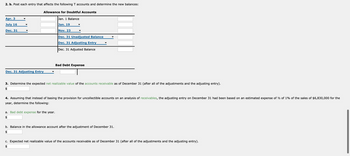
FINANCIAL ACCOUNTING
10th Edition
ISBN: 9781259964947
Author: Libby
Publisher: MCG
expand_more
expand_more
format_list_bulleted
Question
I need help with 2. b. 3. and 4.

Transcribed Image Text:Entries Related to Uncollectible Accounts
The following transactions were completed by The Wild Trout Gallery during the current fiscal year ended December 31:
Jan.
Apr.
July
19 Reinstated the account of Arlene Gurley, which had been written off in the preceding year as uncollectible. Journalized the receipt of
$2,180 cash in full payment of Arlene's account.
3 Wrote off the $12,490 balance owed by Premier GS Co., which is bankrupt.
16 Received 45% of the $22,400 balance owed by Hayden Co., a bankrupt business, and wrote off the remainder as uncollectible.
Nov. 23 Reinstated the account of Harry Carr, which had been written off two years earlier as uncollectible. Recorded the receipt of $3,555 cash
in full payment.
Dec. 31 Wrote off the following accounts as uncollectible (one entry): Cavey Co., $9,395; Fogle Co., $2,790; Lake Furniture, $7,170; Melinda
Shryer, $2,025.
31 Based on an analysis of the $1,106,300 of accounts receivable, it was estimated that $48,100 will be uncollectible. Journalized the
adjusting entry.
Required:
1. Record the January 1 credit balance of $45,800 in a T account presented below in requirement 2b for Allowance for Doubtful Accounts.
2. a. Journalize the transactions. If an amount box does not require an entry, leave it blank. Note: For the December 31 adjusting entry, assume the $1,106,300 balance in accounts receivable reflects the adjustments made during the
year.

Transcribed Image Text:2. b. Post each entry that affects the following T accounts and determine the new balances:
Apr. 3
July 16
Dec. 31
Allowance for Doubtful Accounts
Jan. 1 Balance
Jan. 19
Nov. 23
Dec. 31 Unadjusted Balance
Dec. 31 Adjusting Entry
Dec. 31 Adjusted Balance
Bad Debt Expense
Dec. 31 Adjusting Entry
3. Determine the expected net realizable value of the accounts receivable as of December 31 (after all of the adjustments and the adjusting entry).
$
4. Assuming that instead of basing the provision for uncollectible accounts on an analysis of receivables, the adjusting entry on December 31 had been based on an estimated expense of ½ of 1% of the sales of $6,830,000 for the
year, determine the following:
a. Bad debt expense for the year.
$
b. Balance in the allowance account after the adjustment of December 31.
$
c. Expected net realizable value of the accounts receivable as of December 31 (after all of the adjustments and the adjusting entry).
SAVE
AI-Generated Solution
info
AI-generated content may present inaccurate or offensive content that does not represent bartleby’s views.
Unlock instant AI solutions
Tap the button
to generate a solution
to generate a solution
Click the button to generate
a solution
a solution
Knowledge Booster
Similar questions
arrow_back_ios
arrow_forward_ios
Recommended textbooks for you

 AccountingAccountingISBN:9781337272094Author:WARREN, Carl S., Reeve, James M., Duchac, Jonathan E.Publisher:Cengage Learning,
AccountingAccountingISBN:9781337272094Author:WARREN, Carl S., Reeve, James M., Duchac, Jonathan E.Publisher:Cengage Learning, Accounting Information SystemsAccountingISBN:9781337619202Author:Hall, James A.Publisher:Cengage Learning,
Accounting Information SystemsAccountingISBN:9781337619202Author:Hall, James A.Publisher:Cengage Learning, Horngren's Cost Accounting: A Managerial Emphasis...AccountingISBN:9780134475585Author:Srikant M. Datar, Madhav V. RajanPublisher:PEARSON
Horngren's Cost Accounting: A Managerial Emphasis...AccountingISBN:9780134475585Author:Srikant M. Datar, Madhav V. RajanPublisher:PEARSON Intermediate AccountingAccountingISBN:9781259722660Author:J. David Spiceland, Mark W. Nelson, Wayne M ThomasPublisher:McGraw-Hill Education
Intermediate AccountingAccountingISBN:9781259722660Author:J. David Spiceland, Mark W. Nelson, Wayne M ThomasPublisher:McGraw-Hill Education Financial and Managerial AccountingAccountingISBN:9781259726705Author:John J Wild, Ken W. Shaw, Barbara Chiappetta Fundamental Accounting PrinciplesPublisher:McGraw-Hill Education
Financial and Managerial AccountingAccountingISBN:9781259726705Author:John J Wild, Ken W. Shaw, Barbara Chiappetta Fundamental Accounting PrinciplesPublisher:McGraw-Hill Education


Accounting
Accounting
ISBN:9781337272094
Author:WARREN, Carl S., Reeve, James M., Duchac, Jonathan E.
Publisher:Cengage Learning,

Accounting Information Systems
Accounting
ISBN:9781337619202
Author:Hall, James A.
Publisher:Cengage Learning,

Horngren's Cost Accounting: A Managerial Emphasis...
Accounting
ISBN:9780134475585
Author:Srikant M. Datar, Madhav V. Rajan
Publisher:PEARSON

Intermediate Accounting
Accounting
ISBN:9781259722660
Author:J. David Spiceland, Mark W. Nelson, Wayne M Thomas
Publisher:McGraw-Hill Education

Financial and Managerial Accounting
Accounting
ISBN:9781259726705
Author:John J Wild, Ken W. Shaw, Barbara Chiappetta Fundamental Accounting Principles
Publisher:McGraw-Hill Education